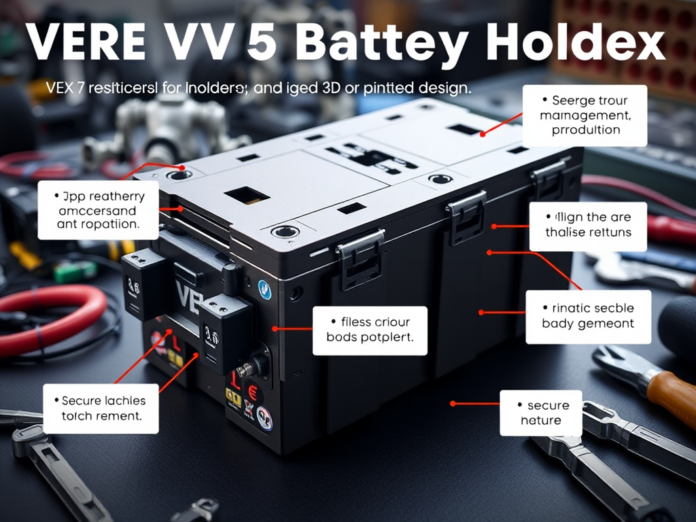In the world of robotics, stability and efficiency are key. Whether you’re competing in a VEX Robotics competition or building custom robots, a secure battery is essential. This is where a VEX V5 battery holder’s 3D print becomes a game-changer. A custom holder can enhance your setup, providing both security and a professional aesthetic. In this guide, we will cover everything you need to know about 3D printing VEX V5 battery holders. From choosing materials to essential design features, you’ll learn how to create a strong, reliable holder that meets your robotics needs.

Why 3D Print VEX V5 Battery Holders?
Stock battery holders can be bulky, heavy, or not fit the specific requirements of your robot. 3D printing offers a flexible and affordable way to overcome these challenges.
Main Advantages:
- Perfect Fit: Customise the size to your battery and chassis.
- Lightweight: Save precious grams to improve speed and manoeuvrability.
- Cost-Effective: Design and print as many holders as you need at a fraction of store prices.
- Quick Prototyping: Test different designs easily without significant investment.
Custom battery holders improve both the function and the look of your robot.
Best Filament Types for Battery Holders
Choosing the right filament for your battery holder ensures reliability during operation.
Top Options:
- PETG: Best for strength and slight flexibility.
- ABS: High impact resistance, excellent for competition robots.
- Nylon: Superior durability but trickier to print.
- PLA+: A good budget choice if heat isn’t a big concern.
PETG is often the best balance for robotics applications, offering strength without being too brittle.
Essential Design Features for Battery Holders
When creating a battery holder, think beyond just “holding” the battery.
Key Features to Include:
- Secure Latch or Clip: Keep the battery locked even during heavy movements.
- Easy Access: Quick swapping is vital during competitions.
- Cable Management: Built-in channels to keep wires neat and out of the way.
- Mounting Holes: Pre-drilled for easy attachment to your robot’s frame.
The design should protect the battery but also allow for fast maintenance.
Printing Settings for Strong VEX V5 Battery Holders
For battery holders that withstand the rigours of competition, printing settings matter.
- Layer Height: 0.2mm for a balance of speed and strength.
- Infill Density: 50%-70% for maximum strength.
- Perimeters: Use at least three walls for durability.
- Bed Adhesion: Use a brim or raft to prevent warping.
A clean, strong print ensures that your holder won’t fail during a crucial match.
Design Inspiration: Innovative Ideas for Battery Holders
You can find many creative designs or make your own!
Popular Styles:
- Slide-In Holders: Batteries click into place securely with minimal bulk.
- Latch-Based Holders: A small clip holds the battery tightly but is easy to release.
- Velcro Straps Integrated: Mix 3D printed parts with flexible fasteners.
- Double Battery Mounts: For robots that use two power sources.
Combining functionality with lightweight design is key for a winning setup.
Common 3D Printing Mistakes and How to Avoid Them
Poor Strength
- Problem: Holder cracks under pressure.
- Solution: Increase the wall thickness and use stronger materials, such as PETG.
Misaligned Mounting Holes
- Problem: The Holder doesn’t fit on the robot.
- Solution: Double-check measurements before printing.
Battery Doesn’t Fit
- Problem: Too tight or too loose.
- Solution: Always measure your VEX V5 battery accurately before designing.
A little extra planning saves a lot of frustration later.
Is it Worth Buying Pre-Designed Files?
Many online platforms offer high-quality VEX V5 battery holder files, both free and paid.
Paid files usually offer:
- Tested Designs: Reliable and proven to work.
- Optimised Strength: Enhanced durability for competition use.
- Time Savings: Skip the design phase and get right to printing.
If you’re tight on time before a competition, investing in a paid, tested design can give you a competitive edge.
Maintenance Tips for 3d-Printed Battery Holders
After installing your new battery holder, simple care will extend its life.
- Regular Inspections: Check for cracks or wear after matches.
- Secure Mounting: Ensure it is firmly attached to avoid movement during use.
- Proper Storage: Keep your robot and battery holder out of extreme heat or cold.
Taking good care of your holder means fewer problems during critical moments.
READ MORE – The Ultimate Guide to MyChron 5 Cover 3D Print: Protect and Customise Your Racing Gear
FAQs:
- What filament is best for VEX V5 battery holders?
- A1: PETG is best because of its excellent balance of strength and flexibility.
- Can I use PLA for battery holders?
- A2: PLA can work, but it is more brittle. PETG or ABS is better for heavy-duty use.
- How long does it take to print a battery holder?
- A3: Most designs take between 3 and 6 hours, depending on complexity.
- Are there ready-made 3d models for VEX V5 batteries?
- A4: Yes, many free and paid options are available online.
- Can 3d printed holders survive competition use?
- A5: Yes, with the right design and material, they can be very durable and reliable.
Conclusion:
A VEX V5 battery holder’s 3D print project isn’t just about saving money, it’s about building a better robot. Custom holders provide better weight distribution, faster battery swaps, and a more professional appearance. With the right materials, a good design, and proper printing techniques, your holder can handle the pressures of even the most intense competitions.
Invest a little time in 3D printing now, and you’ll gain performance, reliability, and peace of mind on the field.




